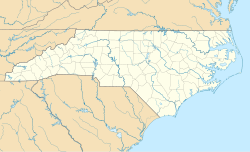Cedar Grove may refer to:
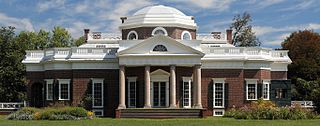
A plantation house is the main house of a plantation, often a substantial farmhouse, which often serves as a symbol for the plantation as a whole. Plantation houses in the Southern United States and in other areas are known as quite grand and expensive architectural works today, though most were more utilitarian, working farmhouses.

Stagville Plantation is located in Durham County, North Carolina. With buildings constructed from the late 18th century to the mid-19th century, Stagville was part of one of the largest plantation complexes in the American South. The entire complex was owned by the Bennehan, Mantack and Cameron families; it comprised roughly 30,000 acres (120 km2) and was home to almost 900 enslaved African Americans in 1860.

Boone Hall Plantation is a historic district located in Mount Pleasant, Charleston County, South Carolina, United States and listed on the National Register of Historic Places. The plantation is one of America's oldest plantations still in operation, as it has continually produced agricultural crops for over 320 years. The majority of this labor, as well as the construction of the buildings and its characteristic bricks, was performed by enslaved African Americans. For this reason, the site was named one of the African American Historic Places in South Carolina in 2009. The historic district includes a 1936 Colonial Revival-style dwelling, and multiple significant landscape features, including an allée of southern live oak trees, believed to have been planted in 1743. The site is open for public tours.

Cedar Crest, also known as Cedar Crest Farms, is a Greek Revival plantation house located near Faunsdale, Alabama. It was built for Kimbrough Cassels Dubose in 1850 by Albert Prince, a slave. Dubose, born in Darlington District, South Carolina was educated at the preparatory school of Prof. Stafford who later was of the faculty of the University of Alabama. His wife was Miss Elizabeth Boykin Witherspoon also of Darlington District, South Carolina, and they had seven sons and four daughters: John Witherspoon, James Henry, Jr., Eugene, Nicholas William, Francis Marion, Lemuel Benton and Edwin Dargan-the daughters Louisa, Rosalie, Augusta and Adele. The plantation was worked by the forced labor of as many as 130 enslaved persons. The house is one-and-a-half stories with side gables, but has been simplified. It originally had side wings, with adjoining porches across the front. These were removed in 1939, leaving the small central front portico. Another historic plantation house, Altwood, was moved from a nearby location to the Cedar Crest grounds in 1988. The house was added to the National Register of Historic Places on August 5, 1993, as a part of the Plantation Houses of the Alabama Canebrake and Their Associated Outbuildings Multiple Property Submission.
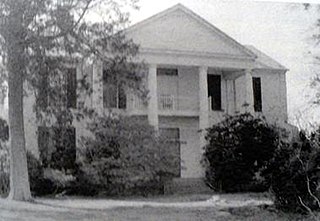
Cedar Haven was a historic Greek Revival plantation house located near Faunsdale, Alabama. It was built in 1850 by Phillip J. Weaver. Weaver was a prominent merchant and planter. He was born in Mifflintown, Pennsylvania in 1797 and relocated to Selma from Uniontown, Maryland in 1818. He ran a very successful store in Selma and also maintained a home there. Weaver was the paternal grandfather of the artist Clara Weaver Parrish.

The Stone Plantation, also known as the Young Plantation and the Barton Warren Stone House, is a historic Greek Revival-style plantation house and one surviving outbuilding along the Old Selma Road on the outskirts of Montgomery, Alabama. It had been the site of a plantation complex, and prior to the American Civil War it was known for cotton production worked by enslaved people.

Ramah Presbyterian Church and Cemetery is a historic Presbyterian church and cemetery located near Huntersville, Mecklenburg County, North Carolina. The current church sanctuary was built in 1881, and is a rectangular, gable-front vernacular Greek Revival / Italianate style frame building. It is three bays wide and has segmental-arched, double-hung sash windows and a tall rectangular and segmental-arched louvered vent. Also on the property is a one-story, log Fellowship Building built in 1935. The cemetery contains approximately 500 burials, with the oldest dating to about 1800.
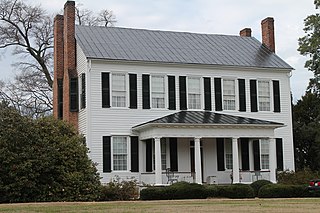
Mount Mourne Plantation is a former Southern plantation and historic house located in Mount Mourne, Iredell County, North Carolina. It was built in 1836, and is a two-story, five-bay transitional Federal / Greek Revival style frame dwelling. It features a hipped roof entrance portico with four fluted Tuscan order columns.

Latta Place, also known as Latta House, is a historic house located in Huntersville, North Carolina near Mountain Island Lake. Built in about 1800 in a Federal style, the plantation also contains some elements of Georgian design, including the house's main staircase.

Cedar Grove is a historic plantation house and farm located near Clarksville, Mecklenburg County, Virginia. The house was built in 1838, and is a Greek Revival style brick dwelling. It consists of a large one-story block on a raised basement with a hipped roof capped with a smaller clerestory with a hipped roof and modern flanking one-story brick wings the historic central block. The front and rear facades feature entry porches with six Doric order columns. Also on the property are the contributing ice house and smokehouse dating from 1838, and a number of other secondary structures and agricultural buildings.
Rufus Reid (1797–1854) was an American plantation owner, businessman and politician from North Carolina.
Abrams Plains is a historic plantation house located near Stovall, Granville County, North Carolina. The house was built by the forced labor of enslaved people to be the main living quarters of an agricultural estate owned by Samuel Smith, a prominent member of the Granville Count community before, during, and after the Revolutionary War.

Potts Plantation is a historic plantation complex and national historic district located near Cornelius, Mecklenburg County, North Carolina. The district encompasses 11 contributing buildings, 12 contributing sites, and 4 contributing structures in rural Mecklenburg County. The plantation seat was built in 1811, and consists of a two-story, three-bay, weatherboarded log house on a low brick foundation with flanking one-story wings added in 1947. The house has Federal, Late Victorian, and Colonial Revival style design elements. Associated with the plantation seat are the contributing smokehouse, dependency, poultry house, double-pen log barn work area, and corn crib. Other notable contributing resources are the Slave Cemetery, five tenant complexes, the Smith Cottage Complex, Smith Cottage, and Potts Cemetery (1946). The Potts Plantation has been the property of the Potts family since 1753.
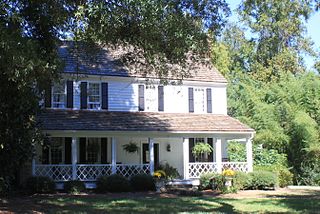
Beaver Dam Plantation House is a historic plantation house located near Davidson, Mecklenburg County, North Carolina. It was built in 1829, and is a two-story, four-bay, single pile Federal style dwelling. It has gable roof, brick exterior end chimneys, and a one-story, full-width, shed roof porch. It was the home of William Lee Davidson, Jr., son of William Lee Davidson and the people he enslaved to work the plantation. It was also the site of the committee meeting of the Concord Presbytery in April 1835, during which the location of Davidson College was determined.
Holly Bend, also known as Hollywood, is a historic plantation house located near Huntersville, Mecklenburg County, North Carolina. It was built between 1795 and 1800, and is a two-story, five bay by two bay, frame dwelling with Federal style design elements. It has gable roof, brick exterior end chimneys, and a one-story, full-width, hip roof porch.
Benjamin W. Davidson House, also known as Oak Lawn, is a historic plantation house located near Huntersville, Mecklenburg County, North Carolina. It was built about 1820, and is a two-story, five-bay, Georgian / Federal style frame dwelling. It has gable roof and exterior brick end chimneys. The front facade have one-story, three-bay, hipped roof porch.
Huntersville Colored High School, also known as Torrence-Lytle High School, is a historic high school complex located at Huntersville, Mecklenburg County, North Carolina. The main building is a variegated red brick, Colonial Revival main block built in 1937 with two-story International Style wings constructed in 1957. The original section was built under the auspices of the Public Works Administration. Also on the property is the elementary school building built in 1953 and a gymnasium built in 1957. The elementary school is a long, one-story, rectangular, red brick building. The complex continued to function as a public school until 1966.
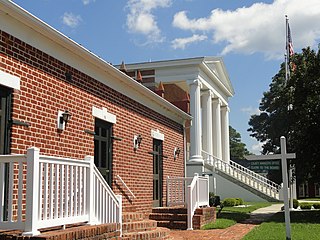
Northampton County Courthouse Square is a historic courthouse complex located at Jackson, Northampton County, North Carolina. The courthouse was built in 1858, and is a tall one-story, three bay by three bay, Greek Revival style temple-form brick building. It sits on a raised basement and features an imposing prostyle tetrastyle portico with great fluted Ionic order columns. The building was remodeled and a two-story rear addition built in 1939 by the Works Progress Administration. The clerk's and register's office was built in 1831, and is a one-story brick building with stepped parapet gable ends and a plaster cornice. A later clerk's office was built in 1900 between the 1831 building and the courthouse.
Purefoy–Dunn Plantation is a historic plantation and national historic district located near Wake Forest, Wake County, North Carolina. The Greek Revival style plantation house was built about 1814 and remodeled about 1850. It is a two-story, L-shaped, heavy timber frame building. It has a low hipped roof and is sheathed in clapboards. The front portico was removed in the 1960s or early 1970s. Also on the property is a contributing mid-19th century gable-roofed frame smokehouse.

